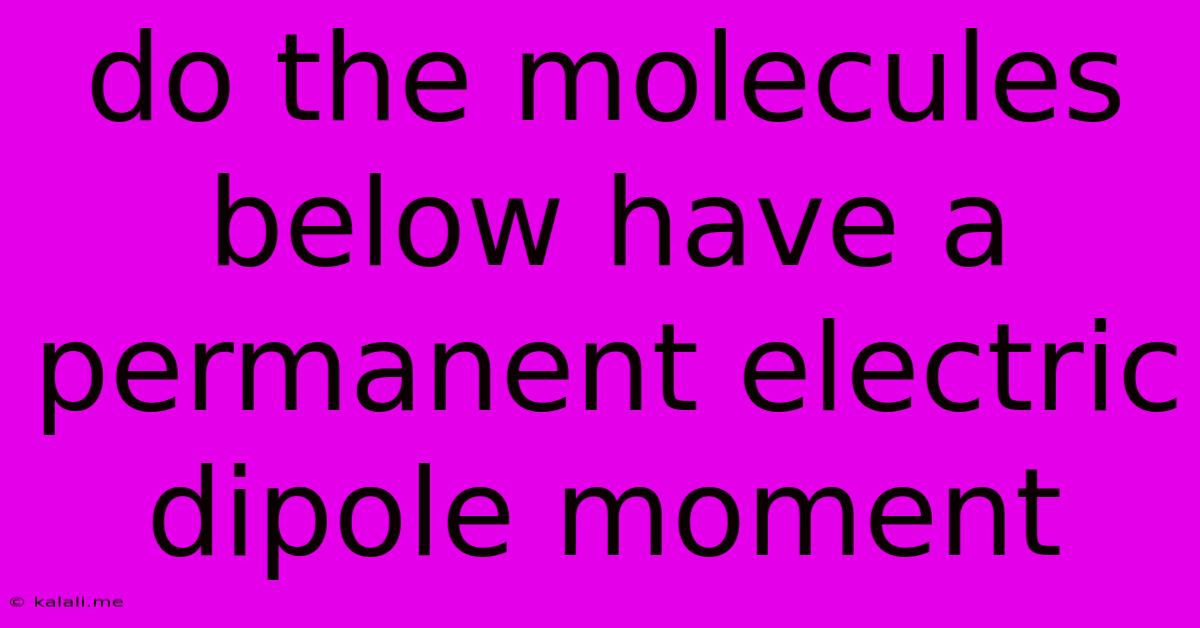Do The Molecules Below Have A Permanent Electric Dipole Moment
Kalali
Jun 13, 2025 · 3 min read

Table of Contents
Do the Molecules Below Have a Permanent Electric Dipole Moment?
This article explores the concept of permanent electric dipole moments and examines whether several example molecules possess them. Understanding molecular polarity is crucial in various fields, including chemistry, physics, and materials science, influencing properties like solubility, boiling point, and reactivity. A molecule's dipole moment is determined by the distribution of electron density and the presence of polar bonds. Let's dive into the specifics.
A permanent electric dipole moment arises when there's an uneven distribution of charge within a molecule. This occurs when the centers of positive and negative charge do not coincide. This imbalance typically results from polar bonds, where one atom attracts electrons more strongly than the other, leading to a partial positive charge (δ+) on one atom and a partial negative charge (δ-) on the other. However, the overall molecular geometry plays a vital role; even with polar bonds, a symmetrical arrangement can cancel out the individual bond dipoles, resulting in a zero net dipole moment.
To determine if a molecule has a permanent dipole moment, we need to consider both the polarity of individual bonds and the molecule's overall geometry. We'll use VSEPR (Valence Shell Electron Pair Repulsion) theory to predict the molecular shape.
Example Molecules and Their Dipole Moments
Let's analyze several molecules:
1. Carbon Dioxide (CO₂):
- Bond Polarity: C=O bonds are polar due to the higher electronegativity of oxygen compared to carbon.
- Molecular Geometry: Linear. The two C=O bond dipoles are equal in magnitude and point in opposite directions, perfectly canceling each other out.
- Dipole Moment: Zero. CO₂ is a nonpolar molecule despite having polar bonds.
2. Water (H₂O):
- Bond Polarity: O-H bonds are polar due to oxygen's higher electronegativity.
- Molecular Geometry: Bent (V-shaped). The two O-H bond dipoles do not cancel each other out due to the bent geometry; they add vectorially resulting in a net dipole moment.
- Dipole Moment: Non-zero. H₂O is a polar molecule.
3. Methane (CH₄):
- Bond Polarity: C-H bonds have a small difference in electronegativity, resulting in only slightly polar bonds. Often considered non-polar for practical purposes.
- Molecular Geometry: Tetrahedral. The four C-H bond dipoles are equal in magnitude and point towards the vertices of a tetrahedron, canceling each other out perfectly.
- Dipole Moment: Zero. CH₄ is a nonpolar molecule.
4. Ammonia (NH₃):
- Bond Polarity: N-H bonds are polar due to nitrogen's higher electronegativity.
- Molecular Geometry: Trigonal pyramidal. The three N-H bond dipoles do not cancel each other out completely due to the pyramidal geometry, resulting in a net dipole moment. The lone pair on nitrogen also contributes to the overall dipole moment.
- Dipole Moment: Non-zero. NH₃ is a polar molecule.
5. Carbon Tetrachloride (CCl₄):
- Bond Polarity: C-Cl bonds are polar due to the higher electronegativity of chlorine.
- Molecular Geometry: Tetrahedral. The four C-Cl bond dipoles are equal in magnitude and symmetrically arranged, canceling each other out.
- Dipole Moment: Zero. CCl₄ is a nonpolar molecule.
Factors Influencing Dipole Moment
Several factors influence a molecule's dipole moment:
- Electronegativity difference: A larger difference in electronegativity between atoms in a bond leads to a more polar bond and contributes more significantly to the overall dipole moment.
- Bond length: Longer bond lengths generally lead to smaller dipole moments.
- Molecular geometry: The spatial arrangement of atoms and bonds is crucial. Symmetrical geometries often lead to zero dipole moments even with polar bonds.
- Lone pairs of electrons: Lone pairs of electrons on the central atom can significantly contribute to a molecule's dipole moment, as they create an uneven distribution of charge.
By considering these factors and applying VSEPR theory to predict molecular geometries, we can effectively determine whether a molecule possesses a permanent electric dipole moment. Remember that the presence of polar bonds is a necessary but not sufficient condition for a molecule to have a net dipole moment. The overall molecular symmetry plays an equally crucial role.
Latest Posts
Latest Posts
-
The Distance From Crest To Crest Is Called
Jun 14, 2025
-
Which Word Is An Antonym Of Accelerate
Jun 14, 2025
-
Which Of The Following Enzymes Is Found In The Mouth
Jun 14, 2025
-
Which Of The Following Is A Closed Question
Jun 14, 2025
-
A Place Where An Organism Lives
Jun 14, 2025
Related Post
Thank you for visiting our website which covers about Do The Molecules Below Have A Permanent Electric Dipole Moment . We hope the information provided has been useful to you. Feel free to contact us if you have any questions or need further assistance. See you next time and don't miss to bookmark.